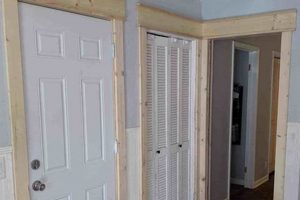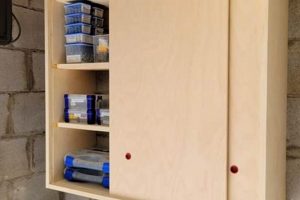A do-it-yourself sliding door, often constructed from wood and hardware readily available at home improvement stores, replicates the rustic aesthetic of traditional agricultural structures. These doors, commonly used as interior design elements, offer a space-saving alternative to conventional swing doors. For instance, a homeowner might construct one to separate a living room from a dining area, providing both functionality and visual appeal.
These doors provide a unique blend of functionality and style, adding character to residential or commercial spaces. Historically, similar sliding mechanisms were essential for managing access to agricultural buildings. The modern adaptation allows individuals to customize their living environments, potentially increasing property value through enhanced aesthetics and efficient use of space. Moreover, constructing one can be a cost-effective alternative to purchasing pre-made doors, especially for those seeking a specific size or design.
The following sections will detail the materials, tools, and step-by-step instructions necessary for fabricating a functional and aesthetically pleasing alternative to standard doors. Subsequent discussions will explore various design considerations, hardware options, and safety precautions relevant to the successful completion of such a project.
Essential Considerations for a Successful Project
The successful fabrication and installation of a sliding door system necessitate careful planning and meticulous execution. The following considerations will enhance project outcomes and ensure long-term functionality.
Tip 1: Material Selection is Paramount: The choice of wood directly impacts structural integrity and aesthetic appeal. Opt for kiln-dried lumber to minimize warping and cracking after construction. Consider the wood’s grain pattern and color to complement the surrounding dcor.
Tip 2: Precise Measurements are Crucial: Accurate measurements of the door opening are essential for determining the dimensions of the door slab. Account for any necessary overlaps to ensure privacy and prevent drafts. Double-check all measurements before cutting materials.
Tip 3: Hardware Compatibility is Key: Select hardware appropriate for the door’s weight and intended use. The track system should be rated to support the door’s mass, and rollers should provide smooth and quiet operation. Verify that all mounting hardware is compatible with the wall construction.
Tip 4: Prioritize Structural Integrity: Properly join wood components using screws, glue, and reinforcing brackets. Ensure all connections are secure to prevent sagging or separation over time. Consider adding a diagonal brace for increased stability, especially for larger doors.
Tip 5: Ensure Smooth Operation: Install the track system level and plumb. Use shims as needed to compensate for uneven walls. Lubricate rollers periodically to maintain smooth gliding action. Consider installing a floor guide to prevent the door from swaying.
Tip 6: Address Safety Concerns: Be mindful of potential pinch points between the door and the wall. Install appropriate bumpers or stops to prevent injury. If the door is heavy, consider installing a soft-close mechanism to prevent slamming.
Tip 7: Finishing Enhances Durability: Apply a protective finish to the wood to prevent moisture damage and enhance its appearance. Consider using a stain to highlight the wood grain and a sealant to protect against scratches and stains.
Adherence to these guidelines will contribute significantly to the creation of a durable, functional, and aesthetically pleasing system. Thoughtful planning and diligent execution are vital for achieving a professional-grade result.
The subsequent sections of this article will delve into specific design considerations and advanced techniques, further enhancing the reader’s ability to create a unique and personalized sliding door.
1. Accurate Measurements
The fabrication of a sliding door necessitates precise dimensional assessments to ensure proper fit and functionality within the intended space. Deviations from accurate measurements can compromise the door’s operational capabilities and aesthetic integration.
- Door Opening Dimensions
Precise measurement of the door opening’s height and width forms the foundational element for determining the door slab’s dimensions. Failure to accurately assess these dimensions may result in a door that is too large, hindering installation, or too small, creating unsightly gaps and compromising privacy. For example, if the opening is measured as 80 inches in height but is actually 79.5 inches, the resulting door will either require trimming or will not fit properly.
- Track Length Determination
Track length is directly correlated with the door’s width and the desired range of motion. Inadequate track length can restrict the door’s ability to fully open, negating its space-saving advantages. Conversely, excessive track length presents an unnecessary aesthetic distraction. A track length calculation must incorporate both the door’s width and any desired overlap beyond the opening’s edge. For example, a 36-inch wide door may require a 72-inch track to allow it to completely clear a 36-inch opening.
- Hardware Placement and Alignment
Hardware installation, including brackets and rollers, relies on precise and consistent measurements to ensure smooth operation and structural stability. Misaligned hardware can cause binding, uneven weight distribution, and premature wear. Uniform spacing between mounting points and accurate perpendicularity relative to the door’s edges are essential. For example, if rollers are not installed at precisely the same height, the door may lean or fail to glide smoothly along the track.
- Wall Clearance Considerations
Accounting for wall clearance is imperative to prevent interference between the door and adjacent architectural elements, such as trim or light fixtures. Accurate measurements determine the required offset, ensuring the door operates without obstruction. Failure to consider wall clearance may necessitate costly alterations or a redesign of the door’s mounting system. For example, if a wall protrudes slightly, the door’s design or mounting system must compensate to allow unimpeded movement.
The accuracy of these measurements fundamentally influences the final quality and utility of any sliding door. Neglecting the importance of precise dimensional assessment can lead to significant challenges during the construction and installation phases, impacting both the aesthetic appeal and the functional performance of the finished product.
2. Hardware Selection
Hardware selection represents a critical determinant of the functionality, longevity, and aesthetic appeal of any constructed sliding door system. Careful consideration of hardware specifications is paramount to ensure seamless operation, structural integrity, and visual coherence within the intended environment.
- Track Systems and Weight Capacity
The track system forms the backbone of the installation, dictating the door’s movement and supporting its overall weight. Insufficient weight capacity can lead to premature failure, operational difficulties, and potential safety hazards. Selecting a track system rated to exceed the door’s weight by a substantial margin provides an added safety factor and ensures smooth, reliable performance. For instance, a door weighing 150 pounds should ideally be paired with a track system rated for at least 200 pounds.
- Roller Mechanisms and Bearing Quality
Roller mechanisms facilitate the door’s smooth gliding action along the track. Bearing quality directly impacts the ease of operation and noise levels. High-quality bearings minimize friction and provide a quiet, effortless experience. Conversely, inferior bearings can result in a noisy, jerky motion and a shorter lifespan. Ball bearing rollers are generally preferred for their durability and smooth performance compared to friction-based rollers.
- Hangers and Mounting Hardware
Hangers connect the door slab to the roller mechanisms, transferring the door’s weight to the track system. Robust hangers, constructed from durable materials such as steel, are essential for maintaining structural integrity. Mounting hardware, including bolts, screws, and brackets, must be appropriately sized and securely fastened to prevent loosening or detachment. Improper mounting can compromise the door’s stability and safety. For example, using undersized screws to attach the hangers can lead to the door detaching from the track.
- Guiding Systems and Stabilization
Guiding systems, such as floor guides or wall-mounted guides, prevent the door from swaying or swinging during operation. These systems ensure consistent alignment and minimize the risk of damage to the door or surrounding surfaces. Without a proper guiding system, the door can be prone to uncontrolled movement, leading to instability and potential hazards. A simple floor-mounted guide, for instance, can significantly improve the door’s stability and prevent it from swinging away from the wall.
The interplay between these hardware components dictates the overall performance and longevity of the sliding door system. Proper hardware selection, therefore, constitutes a fundamental element in achieving a successful and satisfying project. Neglecting these considerations can lead to operational issues, safety concerns, and a diminished aesthetic outcome.
3. Wood Type
Wood selection exerts a profound influence on the structural integrity, aesthetic qualities, and overall lifespan of a constructed sliding door. The properties inherent to different wood species directly impact the door’s resistance to warping, susceptibility to moisture damage, and ability to withstand daily wear and tear. The choice of wood also shapes the visual character of the door, ranging from the rustic charm of reclaimed lumber to the refined elegance of hardwoods. For instance, using softwood like pine may result in a more cost-effective option, but it is more prone to dents and scratches compared to hardwood. A decision to incorporate reclaimed wood contributes to a sustainable design approach, yet necessitates careful inspection for structural soundness and the presence of pests.
Practical application necessitates aligning wood selection with the intended purpose and environmental context of the sliding door. In high-traffic areas or locations prone to moisture exposure, employing hardwoods such as oak or maple provides increased durability and resistance to damage. Alternatively, in dry, low-impact environments, softwoods like pine or cedar may suffice, offering a more economical option. The finishing process further enhances the wood’s protective qualities, with sealants and varnishes mitigating the effects of moisture and UV exposure. For example, a door separating a bathroom from a bedroom would benefit from a water-resistant hardwood or a properly sealed softwood to prevent warping and moisture damage.
In summary, wood type represents a foundational consideration in any sliding door project. Its selection directly affects the door’s durability, aesthetic appeal, and long-term performance. While cost considerations often influence the decision-making process, prioritizing wood species that align with the intended use and environmental conditions is paramount for achieving a successful and enduring outcome. Ignoring the specific properties of different woods can result in premature failure, increased maintenance requirements, and a diminished aesthetic appeal, ultimately undermining the value and functionality of the door.
4. Joinery Techniques
Proper joinery constitutes an indispensable element in the successful construction of a durable and aesthetically pleasing sliding door. These techniques, which involve securely fastening individual pieces of wood together, dictate the structural integrity of the door slab and its resistance to warping or separation over time. Mastery of fundamental joinery principles is, therefore, essential for any individual undertaking a sliding door project.
- Mortise and Tenon Joints
Mortise and tenon joints offer exceptional strength and stability. The tenon, a projecting tongue of wood, fits precisely into the mortise, a corresponding recess. This creates a mechanical interlock that resists tension and shear forces. In a sliding door, mortise and tenon joints can be used to connect the stiles (vertical members) and rails (horizontal members), creating a rigid framework that supports the door’s weight and prevents sagging. The use of glue and mechanical fasteners, such as screws, further enhances the joint’s strength. A well-executed mortise and tenon joint provides a reliable connection that withstands the stresses associated with the door’s operation.
- Pocket Hole Joinery
Pocket hole joinery provides a simplified method for creating strong, concealed joints. Angled holes are drilled into one piece of wood, allowing screws to be driven into an adjacent piece. This creates a mechanical bond that is both secure and aesthetically pleasing, as the screw heads are hidden from view. In sliding door construction, pocket hole joinery can be used to attach panels to the frame, creating a visually seamless surface. This technique is particularly well-suited for projects where speed and ease of assembly are priorities. The strategic placement of pocket holes ensures even weight distribution and prevents stress concentrations that could lead to joint failure.
- Butt Joints with Reinforcement
Butt joints, where two pieces of wood are joined end-to-end, represent the simplest form of joinery. However, butt joints alone lack significant strength and require reinforcement to prevent separation. Reinforcement can be achieved through the use of glue, screws, dowels, or metal fasteners. In the context of a sliding door, butt joints can be employed to connect boards to create larger panels, provided that adequate reinforcement is implemented. For example, applying glue and screws along the length of the joint, coupled with the addition of a backing board, can significantly increase its strength and resistance to warping. The effectiveness of a reinforced butt joint depends on the quality of the adhesive, the spacing of the fasteners, and the type of reinforcement used.
- Dovetail Joints (Advanced)
Dovetail joints, characterized by their interlocking, wedge-shaped pins and tails, represent a pinnacle of woodworking craftsmanship. Dovetails offer exceptional strength and resistance to pulling forces, making them ideal for applications where durability and aesthetic appeal are paramount. While more complex to execute than other joinery techniques, dovetails provide a robust and visually striking connection that enhances the value and longevity of a sliding door. Employing dovetails to join the stiles and rails of a sliding door creates a joint that is both structurally sound and aesthetically impressive, showcasing the skill and precision of the craftsman. Proper execution of dovetails requires meticulous planning, accurate cutting, and precise fitting to ensure a tight, seamless joint.
The selection of appropriate joinery techniques is contingent upon factors such as the door’s size, weight, the desired aesthetic, and the level of woodworking expertise possessed by the craftsman. While simpler methods such as pocket hole joinery may suffice for smaller, less demanding projects, more robust techniques like mortise and tenon joints or dovetails are recommended for larger, heavier doors that require greater structural integrity. Ultimately, the successful implementation of these techniques ensures that the sliding door functions smoothly and withstands the rigors of daily use for years to come. It is critical to prioritize long-term reliability.
5. Surface Finishing
Surface finishing constitutes a critical stage in the construction, directly impacting its aesthetic appeal, durability, and resistance to environmental factors. Improper or inadequate finishing can negate the effort invested in material selection and joinery, leading to premature degradation and a compromised visual outcome. For example, a raw wood left exposed to humidity will undergo warping and cracking, undermining structural integrity. Conversely, the application of appropriate sealants and topcoats protects the wood, extending its lifespan and preserving its aesthetic qualities. The choice of finish stain, paint, varnish, or oil should align with the intended aesthetic and the prevailing environmental conditions of the location.
The process involves preparing the wood surface through sanding, filling imperfections, and applying a primer. The selection of the appropriate primer ensures proper adhesion of subsequent coats, enhancing the finish’s longevity and resistance to chipping or peeling. Different finishing techniques produce varied visual effects. Staining enhances the natural grain of the wood, while painting provides a uniform color and conceals the grain pattern. Varnishes and oils offer varying degrees of sheen and protection, influencing the overall aesthetic and the ease of maintenance. For instance, a barn-style door used in a high-traffic area benefits from a durable polyurethane varnish to withstand scratches and scuffs, while a door in a low-humidity environment may require only a light oil finish.
In conclusion, surface finishing represents an integral element in realizing the full potential in any diy project. It serves not merely as an aesthetic enhancement but as a functional safeguard, protecting the underlying wood from damage and extending its lifespan. Challenges may arise in selecting the appropriate finish for specific wood types and environmental conditions, but the careful consideration and proper application of a suitable surface treatment is essential for achieving a long-lasting and visually appealing result. The long-term functionality and appearance of the can be significantly enhanced through proper surface finishing.
6. Track Installation
Track installation is a critical determinant of the operational functionality and long-term stability of any system. The proper execution of this phase ensures smooth and reliable movement, prevents premature wear, and safeguards against potential safety hazards. Its impact on the overall success of a fabrication project cannot be overstated.
- Level and Plumb Mounting
Precise leveling and plumbing of the track system are paramount for smooth, consistent operation. Deviations from true horizontal or vertical alignment can induce binding, uneven weight distribution, and accelerated wear on the rollers. The use of a spirit level or laser level is essential to guarantee accurate positioning. For example, failure to level the track can cause the door to drift open or closed due to gravity, negating its intended functionality.
- Secure Attachment to Wall Structure
The track must be securely anchored to the wall structure to support the weight and operational forces. Utilizing appropriate fasteners and anchoring techniques, based on the wall’s composition (studs, concrete, etc.), is critical. Insufficiently secured tracks can detach from the wall, resulting in catastrophic failure and potential injury. For instance, mounting a heavy track solely to drywall without engaging underlying studs will likely result in the screws pulling free under load.
- Proper Track Spacing and Alignment
Maintaining consistent spacing between the track and the wall, as well as ensuring proper alignment between multiple track sections (if applicable), contributes to smooth and predictable door movement. Inconsistent spacing or misaligned track sections can create friction points and impede the door’s gliding action. The manufacturer’s specifications should be consulted to determine the recommended spacing and alignment tolerances. Small deviations can lead to significant operational problems.
- Integration of Safety Stops and Anti-Jump Mechanisms
Incorporating safety stops at the ends of the track prevents the door from over-traveling and potentially detaching from the system. Anti-jump mechanisms, which secure the rollers to the track, prevent the door from lifting off the track due to accidental bumps or uneven surfaces. These safety features are essential for mitigating potential hazards and ensuring the long-term security of the installation. The omission of these features significantly increases the risk of accidents and damage.
These facets of track installation are intrinsically linked to the overall success and safety of a fabricated sliding door. A properly installed track system provides a stable and reliable platform for the door’s operation, while a poorly installed track can lead to functional problems, safety hazards, and ultimately, project failure. Rigorous attention to detail during the track installation phase is therefore essential for achieving a satisfactory and enduring outcome.
7. Space Optimization
The utilization of a self-constructed sliding door system, often inspired by agricultural building designs, is inextricably linked to the optimization of interior space. Conventional swing doors require a clearance radius equal to their width, rendering adjacent areas unusable. Conversely, sliding doors operate parallel to the wall, freeing up floor space that would otherwise be consumed by the door’s arc of movement. The cause-and-effect relationship is direct: employing a sliding mechanism reduces the spatial footprint, increasing the usable area within a given room. For example, consider a small bathroom where a standard swing door impedes the placement of fixtures or storage. Replacing it with a sliding door allows for more efficient use of the limited square footage, potentially enabling the installation of a larger vanity or additional shelving. The importance of space optimization as a component of this construction is therefore paramount, directly impacting functionality and usability.
The practical significance of this understanding extends beyond individual rooms. In open-plan living spaces, can serve as adaptable partitions, allowing for the creation of temporary zones without permanently dividing the area. This dynamic spatial arrangement enables occupants to modulate the configuration of their living environment based on specific needs, whether it be creating a quiet workspace or expanding the entertaining area. Furthermore, these constructed doors can be designed to conceal storage areas or utilities, integrating functionality seamlessly into the aesthetic design. Consider a loft apartment where a constructed sliding door conceals a home office during non-working hours, thereby preserving the open feel of the living space. This flexibility and adaptability underscore the value of understanding the space-saving potential inherent in the design. They help to hide clutter and allow for greater privacy in a large open space,
In summary, the relationship between space optimization and such a door construction is one of mutual enhancement. By minimizing the space required for operation, these constructions maximize the usability of interior areas. The challenges associated with swing door designs are effectively mitigated through the implementation of the sliding mechanism. Therefore this provides a practical solution for optimizing space in diverse architectural settings. This construction serves as a prime example of how thoughtful design can enhance functionality and improve the overall living experience, particularly in constrained environments. It is an efficient way to maximize the size of a room and to make it look good at the same time.
Frequently Asked Questions
The following represents answers to common inquiries regarding the construction of sliding door systems. These are intended to clarify potential challenges and inform project planning.
Question 1: What constitutes the minimum ceiling height required for a project?
Minimum ceiling height must accommodate the door slab’s height, the track system’s height, and a small clearance gap. Typically, a minimum of 8 feet is recommended, though precise measurements depend on specific design choices. Insufficient ceiling height may necessitate modifications to door or track dimensions.
Question 2: Is specialized hardware required for heavier door slabs?
Yes. Heavier door slabs necessitate robust track systems and heavy-duty rollers rated for the increased weight. Failure to utilize appropriate hardware can lead to premature wear, operational difficulties, and potential safety hazards. Consult hardware specifications to ensure compatibility.
Question 3: What types of wood are best suited for resisting warping?
Kiln-dried hardwoods, such as oak or maple, exhibit superior resistance to warping compared to softwoods. Kiln-drying reduces the wood’s moisture content, minimizing dimensional changes. Properly sealing the wood further mitigates moisture absorption.
Question 4: How can noise from door operation be minimized?
Employing rollers with high-quality bearings, lubricating the track system, and installing sound-dampening materials between the door and the wall can effectively reduce noise. Soft-close mechanisms also prevent slamming, minimizing noise levels.
Question 5: What safety precautions should be observed during construction?
Safety glasses, gloves, and hearing protection are essential. Power tools should be operated with caution, following manufacturer’s instructions. Ensure the work area is well-ventilated, especially when applying finishes. Exercise caution when lifting heavy materials.
Question 6: How does one ensure the door remains securely on the track?
Anti-jump mechanisms, integrated into the roller system, prevent the door from lifting off the track. Regular inspection of the hardware and prompt replacement of worn components are crucial for maintaining safety and operational reliability.
Careful planning and diligent execution contribute significantly to the creation of a safe, functional, and aesthetically pleasing sliding door system. Attention to detail is paramount for achieving a professional-grade result.
The following sections of this article will present case studies highlighting specific design choices and their impacts on overall project outcomes.
Conclusion
This exploration of construction has addressed fundamental considerations, ranging from material selection and joinery techniques to hardware specifications and installation procedures. Precise measurements, structural integrity, and adherence to safety protocols are paramount for successful project completion. The optimization of space through these door systems offers practical advantages in various architectural settings.
The information presented serves as a foundation for informed decision-making. Prospective builders are encouraged to meticulously plan their projects, prioritize safety, and select materials and techniques appropriate for their skill level and the intended application. Further research into specific design nuances and local building codes is advisable prior to commencing construction.







